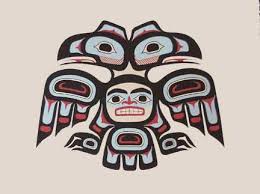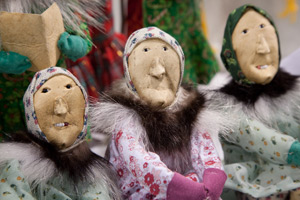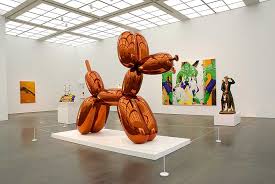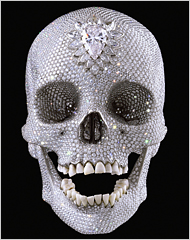This March, the University of Alaska, Fairbanks hosted the Festival of Native Arts as in previous years. Visiting and chatting with the devoted artists as well as the organizers, the dichotomy of artistic expression and the expectations of the consumer base of native arts became obvious to me. Native artists are caught in a triangle of traditional art, consumerism, and the expectation of fulfilling the role of the Other. (The Other, or othering refers to the anthropological concept in which the observer notes the differences between her/ himself from the viewpoint of mainstream culture, leading to objectification, devaluation, and misinterpretation of the observed person/ people. This important concept can be applied in many disciplines. Follow this link to find an example of othering: http://www.washingtonpost.com/blogs/monkey-cage/wp/2014/08/25/othering-ebola-and-the-history-and-politics-of-pointing-at-immigrants-as-potential-disease-vectors/.)
What does it mean to produce ‘authentic Alaskan Native art’? How far can the artist commodify the product, a product that the consumer base expects to represent the diverse Alaskan Native cultures? How can an artist accommodate the market, the guidelines established by the the federal government, the local native corporations, and most importantly, their autonomy? How can an artist maintain the uniqueness of her/ his work without becoming a stereotype- the marked ‘Other’?
The ‘Silver Hand’ emblem is the established mark of authenticity, whereas “[a]ny Alaska Native of 1/4 or more Native blood can register for the state-sponsored program. The Silver Hand is not a mark of quality however, and the authenticity it marks is actually ethnicity as defined by blood quantum” (Hollowell-Zimmer).
 Here the Silver Hand. However, non-native Alaskan Native can sell their art under this seal, seen below:
Here the Silver Hand. However, non-native Alaskan Native can sell their art under this seal, seen below:
 If you are interested in the economics and morality behind the scenes, check out the following links:
If you are interested in the economics and morality behind the scenes, check out the following links:
http://www.culturalsurvival.org/publications/cultural-survival-quarterly/united-states/intellectual-property-protection-alaska-nativ and http://alaskamade.com/
The other issue comes with the restrictive expectations many tourists- the major consumer of Alaskan Native Art- have. Native art, so the expectation (proven by best selling items), has to resemble the often romantic ideas tourists have about natives. Alaska-themed art therefore sells best in gift shops. Below are several examples:
The tribal imagery of the coastal tribes is popular in print and in wood carvings.
Interior tribes are recognized by their excellence in basket weaving.
Dolls in traditional dresses are popular, and so are masks:
However complicated these contemporary issues are for traditional art and their creators, one Alaskan artist serving as a great example of finding the balance between the market, tradition, and self is Wayne G. Price. He is a successful artist, best known for his wood carvings:
The sheer enormity of this project demands attention and the spatial relationship of modernity and tradition offers a successful fusion between the Fourth World Art and modern Alaska. I especially appreciate the dominance this pole has. I can derive aesthetic appreciation for this piece its clarity in design, its symbolism, and its unifying force. (Questions about Fourth World? Follow this link: http://cwis.org/GML/background/FourthWorld/)
 The artistic creativity of Wayne G. Price also includes mask. The above shown mask won the 5th Sealaska Juried Art Competition in Juneau. Here, I appreciate the modern features such as the metal eyebrows alongside traditional Tlingit patterns. Interesting is also the curled hair. The finely worked wood shows Price’s expert wood carving skills. According to the anthropologist Tim Ingold, the differentiation between art and technique is a recent, European development. If we were to accept this division as non-essential, as Ingold suggests, we can arrive at the conclusion that through Price’s skills, we truly have a great piece of art in front of us: aesthetics and the technique as a unified, holistic expression of human artistic expression.
The artistic creativity of Wayne G. Price also includes mask. The above shown mask won the 5th Sealaska Juried Art Competition in Juneau. Here, I appreciate the modern features such as the metal eyebrows alongside traditional Tlingit patterns. Interesting is also the curled hair. The finely worked wood shows Price’s expert wood carving skills. According to the anthropologist Tim Ingold, the differentiation between art and technique is a recent, European development. If we were to accept this division as non-essential, as Ingold suggests, we can arrive at the conclusion that through Price’s skills, we truly have a great piece of art in front of us: aesthetics and the technique as a unified, holistic expression of human artistic expression.
 Here is the artist’s explanation of this print: “Healing Spirit is to my Tlingit culture what an angel is to many other cultures. It is something one does not see physically, but we know it exists. It watches over us and will be there in times of hardship or trauma. It helps to know that Spirit is there. Healing Spirit is for all cultures. We are all here now and must get along with one another.”
Here is the artist’s explanation of this print: “Healing Spirit is to my Tlingit culture what an angel is to many other cultures. It is something one does not see physically, but we know it exists. It watches over us and will be there in times of hardship or trauma. It helps to know that Spirit is there. Healing Spirit is for all cultures. We are all here now and must get along with one another.”
I like the inclusiveness of this piece. The colour scheme is intriguing and typical of Tlingit traditional art, more, it holds meaning for yesterday, today, Tlinglit and ‘is for all cultures’. The power and beauty of the symbolism is obvious and it raises my interest into Tlingit cosmology. The patterns repeat in a comforting, yet lively and interesting manner, raising questions of their significance. The agency of this piece is undeniable: I as the observer and consumer want to know more about the piece, the meaning behind it, and the Tlingit culture.
Wayne G. Price tends to his traditional artistic values while at the same time being an active member in the contemporary Alaskan art community. The artist makes the balance act between the demands of today and tradition is well, being part of the Fourth World, seem easy, defining the question of Alaska Native Art for himself, an example for future native artists.
Sources:
Seay, Laura and Kim Yi Donnie. The long and ugly tradition of treating Africa as a dirty, diseased place. Washington Post: 25th August, 2014.
Hollowell-Zimmer, Julie. Intellectual Property Protection For Alaska Native Arts. Cultural Survival Quarterly: Winter 2000. http://www.culturalsurvival.org/publications/cultural-survival-quarterly/united-states/intellectual-property-protection-alaska-nativ, accessed April 21, 2015.
Price, Wayne G. Wayne G. Price- Tlingit master carver, designer and artist. n.d. http://silvercloudart.com/home, accessed April 21, 2015.
Griggs, Richard. Background on the Term ‘Fourth World’. University of Capetown: Center of World Indigenous Studies, 1992. http://cwis.org/GML/background/FourthWorld/, accessed April 21, 2015.


























